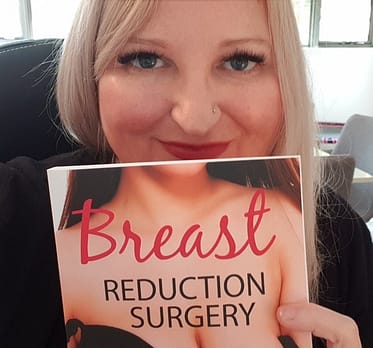Modern surgery is generally safe, though it always carries a risk; complications can and do occur. Most of the women I have spoken with did not experience any complications, though I know of one poor woman who had to have repeated corrective surgery when her nipple and areola died, which sounded very traumatic.
While I knew the risks going into my surgery, for me the benefits of the surgery outweighed the risks. For some women, the risk is too high. And if you’re a smoker or have other health complications, then the risks may not be worth the benefits.
Only you can make that decision, in consultation with your surgeon, but you do need to know the potential worst-case scenarios.
General Surgery Risks
Many of the risks involved in breast reduction surgery are the same as those for any major surgery and include:
- Risks of having general anesthesia, such as allergic reaction and potentially fatal cardiovascular complications such as a heart attack
- Surgical risks such as bleeding or infection
- Breathing difficulties due to the general anesthetic or the tube that is put down your through (endotracheal tube) which can cause swelling, discomfort and loud breathing
- A blood clot in the veins of your legs (deep vein thrombosis) which can move to the lungs (pulmonary embolus) or the brain, and may be life threatening
- Fluid accumulation at the site of the surgery
- Allergic reaction to the suture materials, adhesive tape or other medical materials
- Skin discoloration, permanent pigmentation changes, swelling and bruising
- Damage to blood vessels, nerves, muscles, and lungs (this can be temporary or permanent)
- Fatty tissue deep in the skin could die (this is called fat necrosis)
Breast Reduction Surgery Risks
The additional risks and complications specifically for breast reduction include:
- Changes in breast and nipple sensation (this is one of the things that women fear the most)
- Temporary or permanent areas of numbness
- Asymmetry (unevenness) of the breasts
- Potential partial or total loss of nipple and areola (this one is the scariest to me – the risk of the nipple and areola dying)
- Severe scarring (some women do have extreme scarring in the form of Keloid Scarring – this means that the scars are raised, often itchy, and do not heal like normal scars)
- Some women experience fat necrosis, where the fat clumps together
- Wound healing problems – sometimes a wound will tear open and fail to heal easily (this happened to me and was quite scary)
- Possible need for revision surgery or procedures to fix issues (such as “dog ears” – I have these and did not get them fixed)
If any of these complications happen, then you might have to undergo further surgery to treat the problem. Some issues, though, like reduced breast sensation or numbness, may not be treatable at all.
While there are no guarantees with any surgery, these risks can be minimized by choosing a properly trained and qualified surgeon as well as following their advice before and after surgery.
Other Considerations
Here are some things to consider that may impact your decision to have a breast reduction:
- If you are young and your breasts are still developing, it is best to wait until your breasts are fully developed (it’s often recommended to wait until your early to mid-20s).
- If you still plan to have children and breastfeed, surgeons generally recommend waiting until after this phase of life to have your reduction.
- If you have a significant amount of weight to lose, it is better to get to your ideal weight before surgery, as changes in weight will impact your breast size.
- If you smoke, you are at increased risk of complications, so if you’re planning to quit anyway, use your breast reduction as a motivator to quit smoking.
- If you have breast or nipple piercings, these can cause infection.
Have Realistic Expectations
By reading this book, you are educating yourself about the breast reduction process. The whole aim of this book is to prepare you so that you know what to expect at the various stages of your breast reduction. If you know what to expect, you are more empowered to make the right decisions for you. And you will have less stress and disappointment.
Your Breasts Won’t Look Like Breast Augmentation
I’m sure you know what augmented, or surgically enlarged, breasts look like. They are perky things that sit high on the chest.
The truth is your breasts probably won’t look like this. However, your breasts will probably have quite a natural look and feel to them. If you are after super pert breasts, this can sometimes be achieved with reduction surgery. However, you want to be realistic in your expectations.
You Need to Be Patient
Your breasts will take a long time to heal and settle into their new shape. Some women find their breasts don’t normalize until 12 months after surgery.
There Will Be Scars
Breast reduction surgery has evolved since it was first developed in the 1950’s. The procedure today is more sophisticated, resulting in less scarring. However, there is no way to avoid scars unless you are having a liposuction-only breast reduction.


Read All the Breast Reduction Surgery Blogs
In this special series of blog posts, Ayesha Hilton shares with you:
The Risks & Benefits of Breast Reduction Surgery
The main types of Breast Reduction Techniques
Breast feeding after a Breast Reduction
How to find a surgeon

Get Your Copy of
Breast Reduction Surgery
The Complete Guide to Breast Reduction Surgery & Recovery
